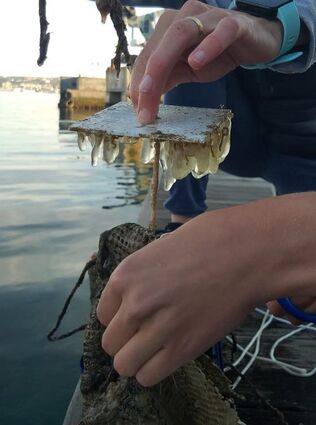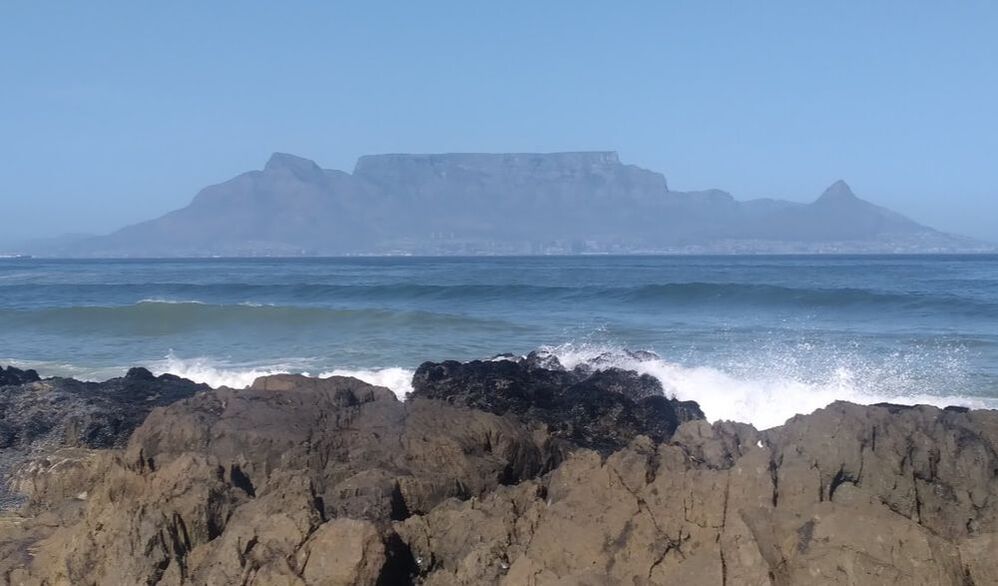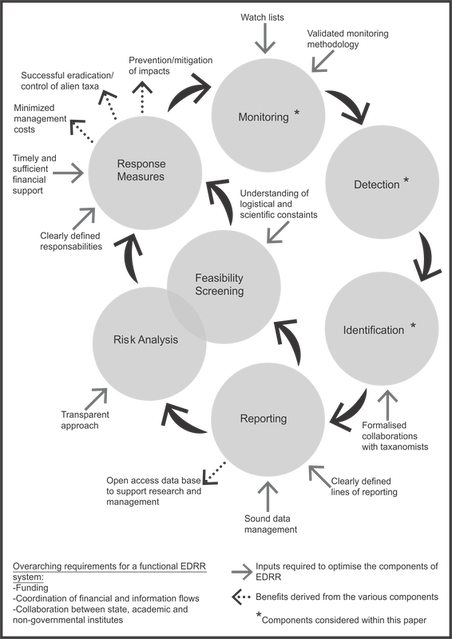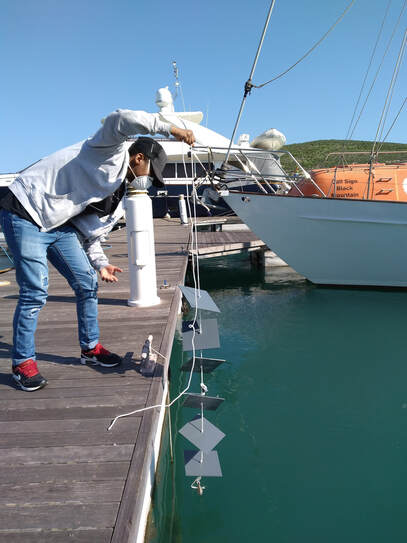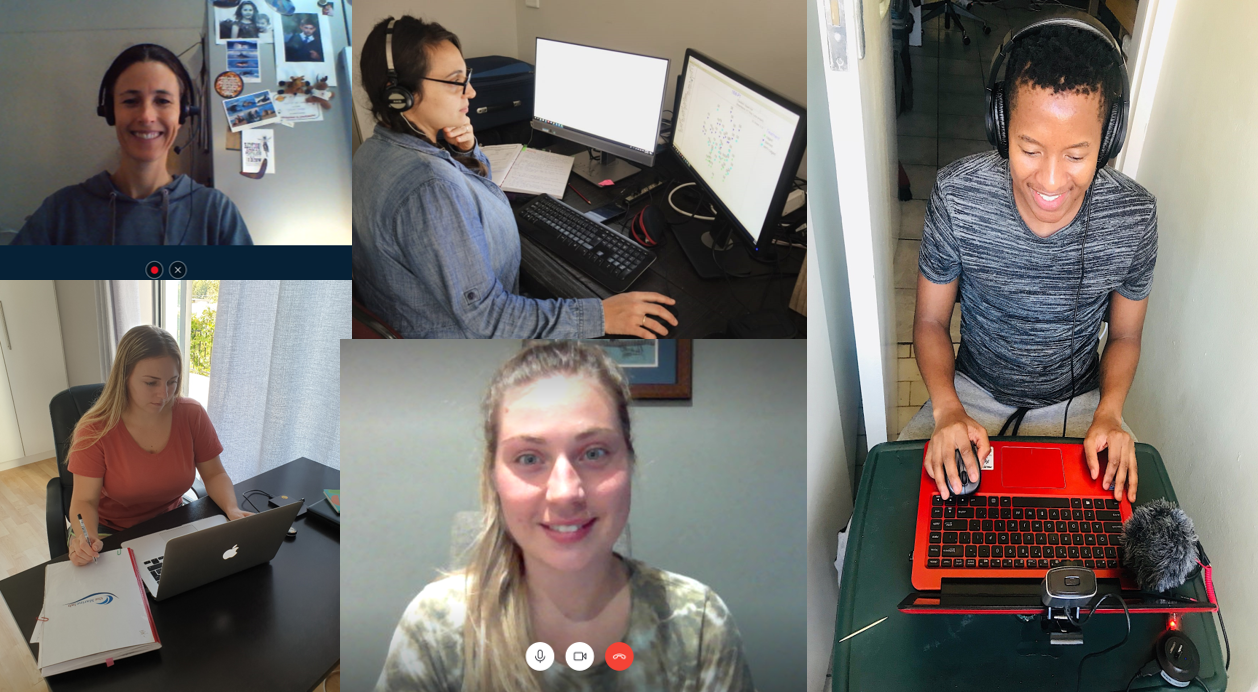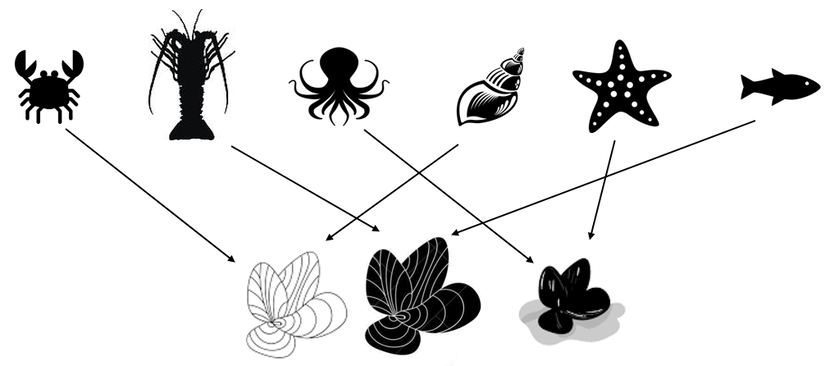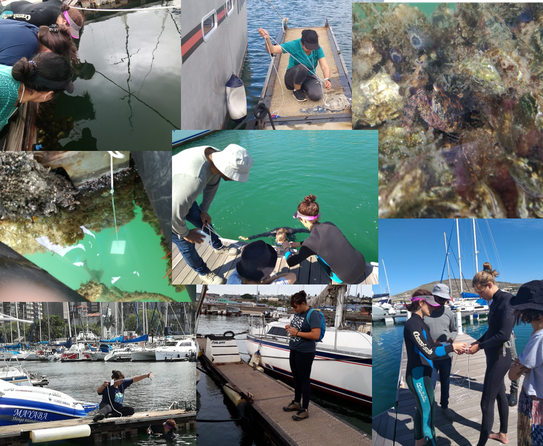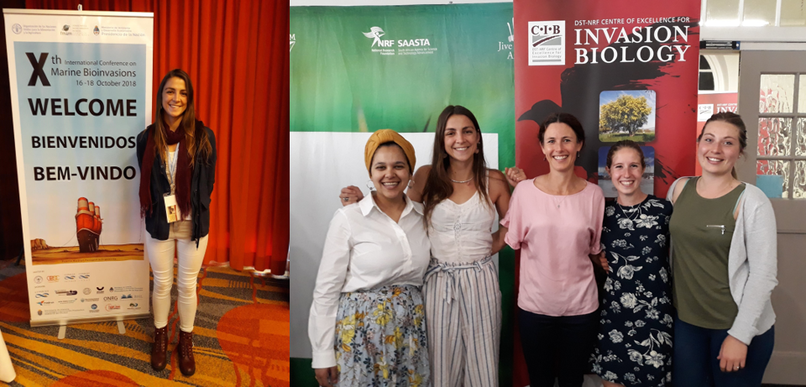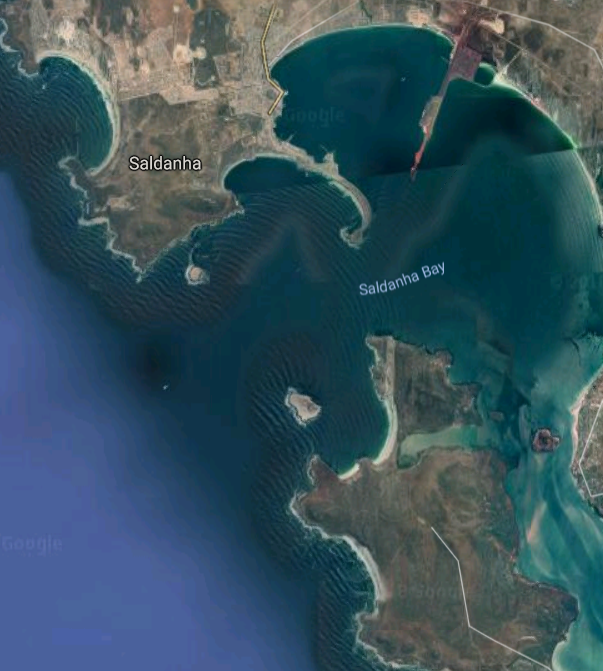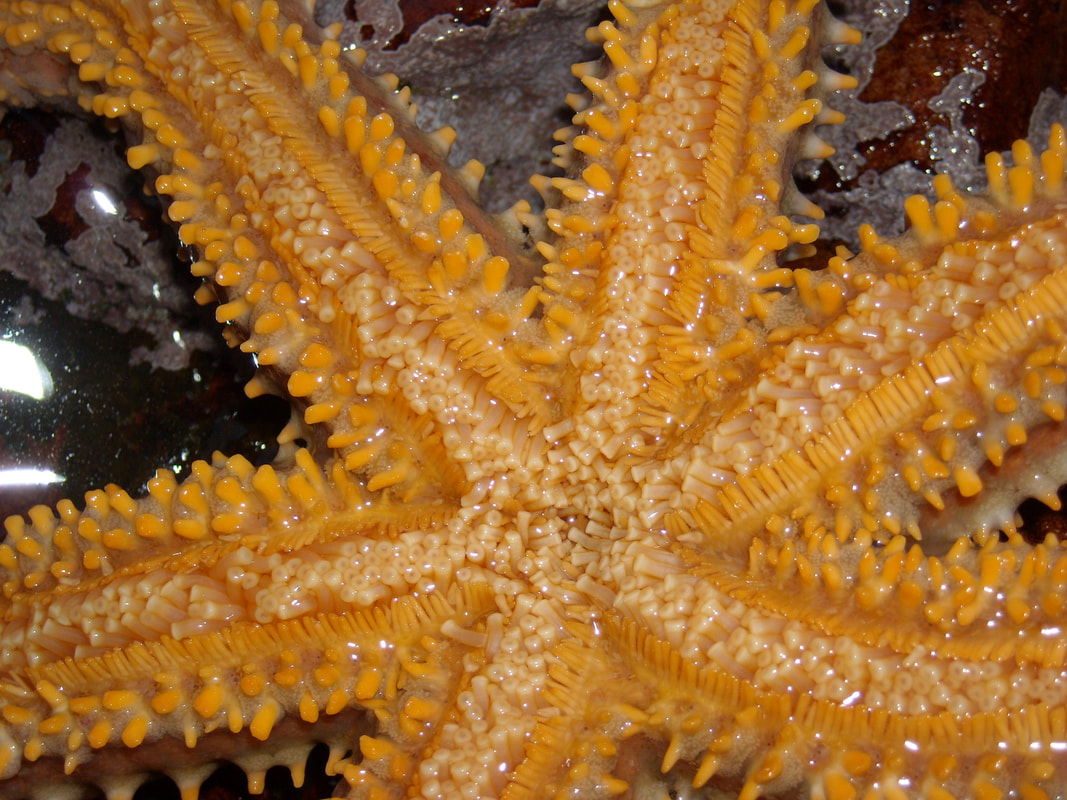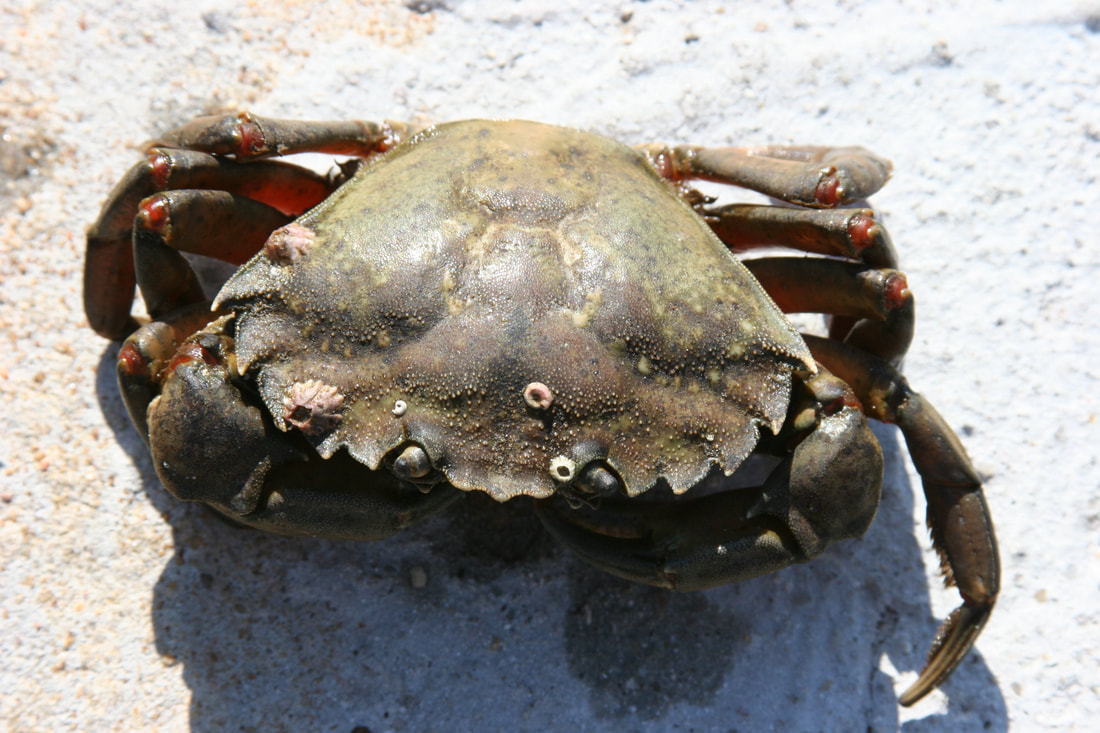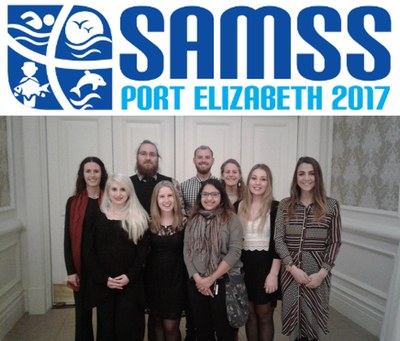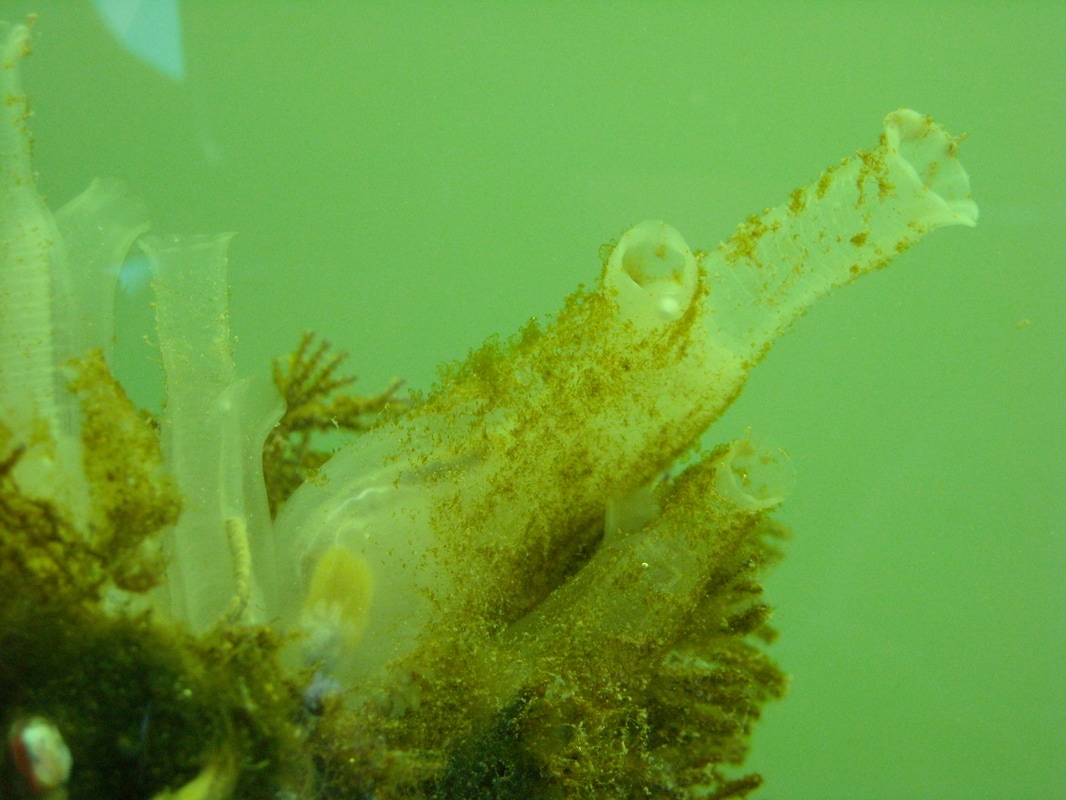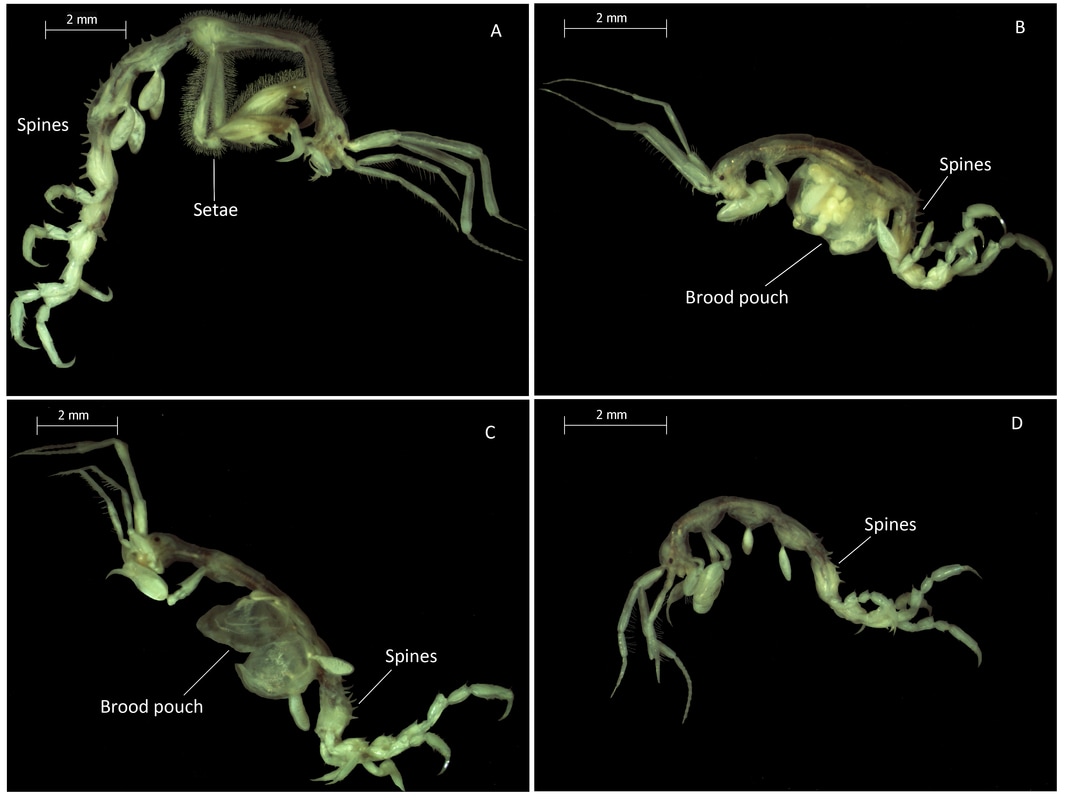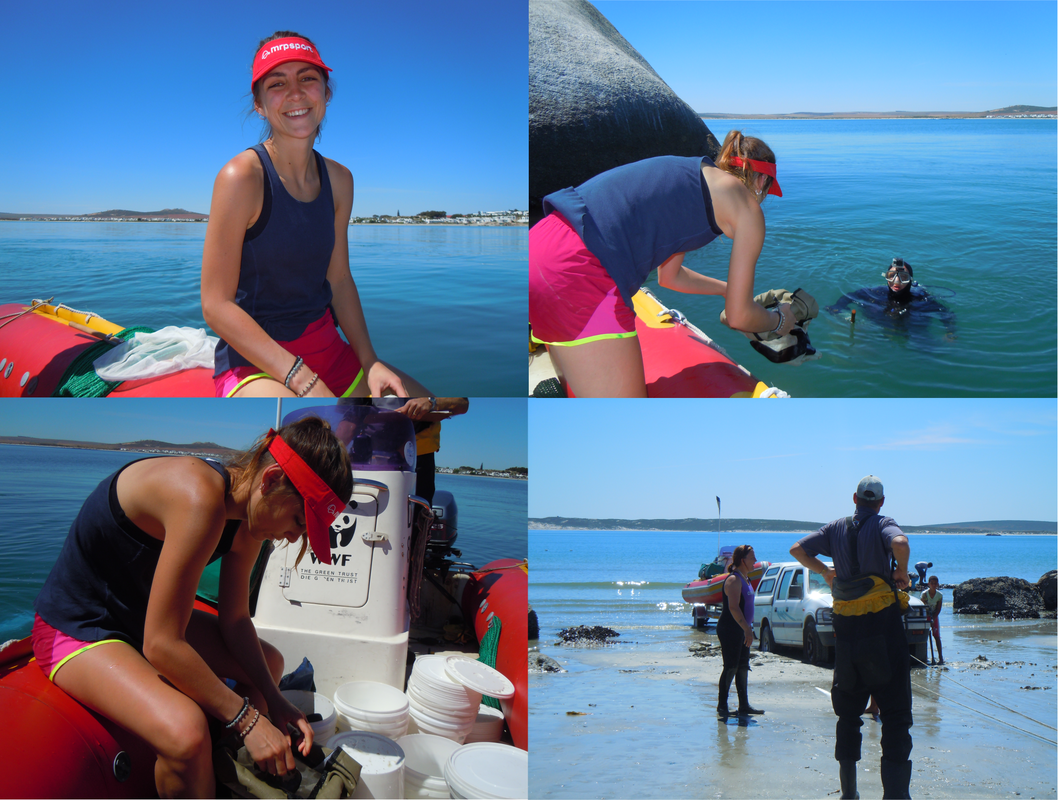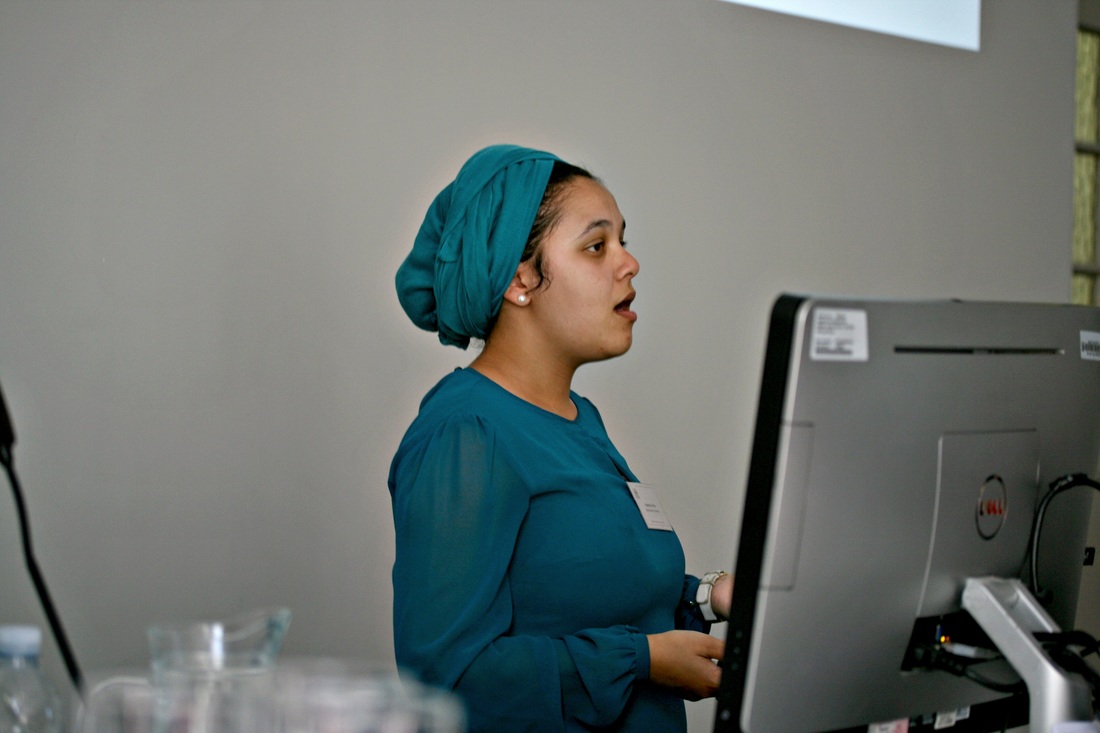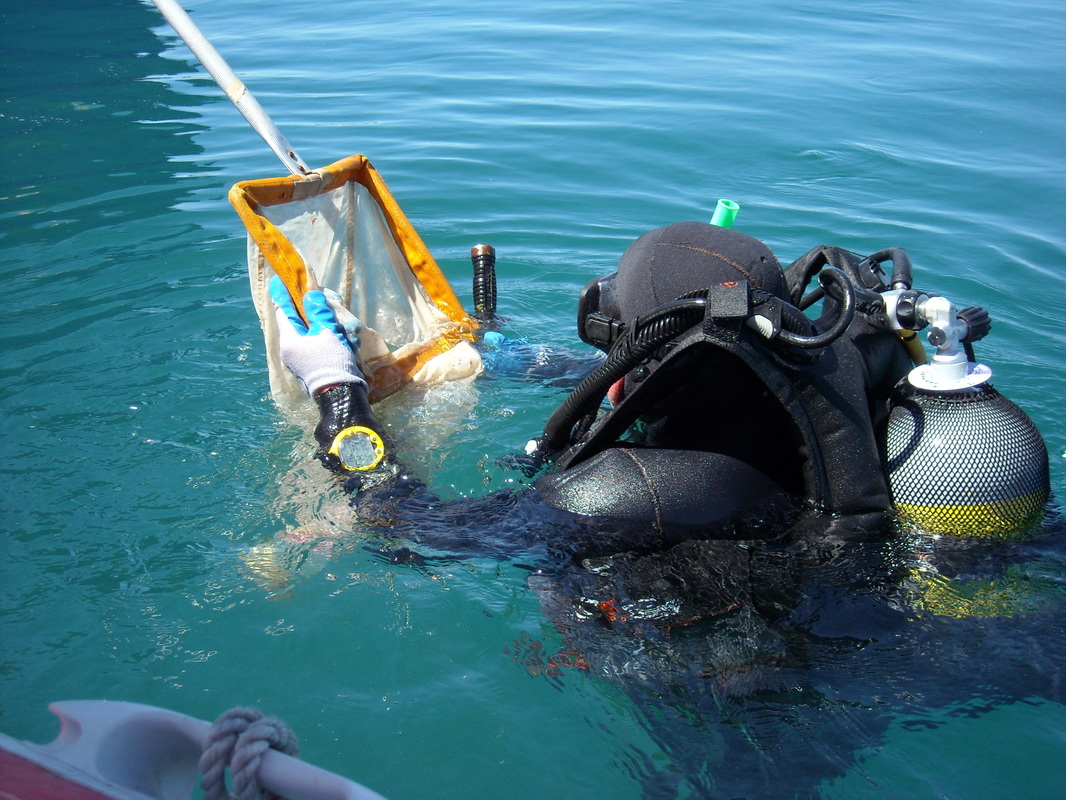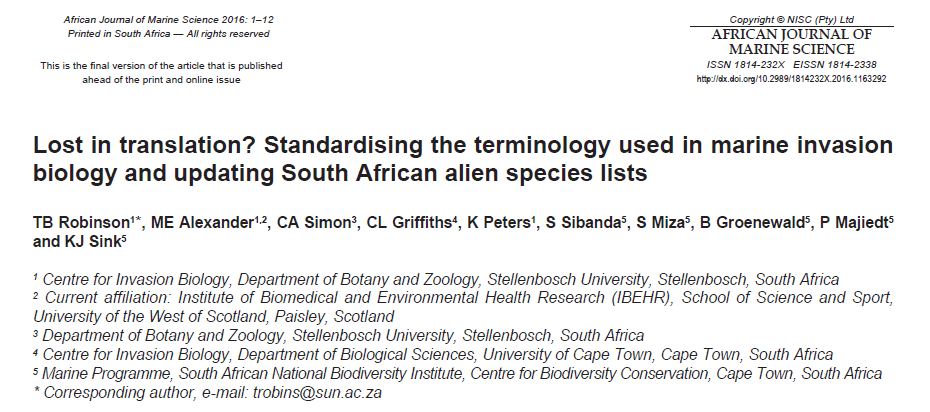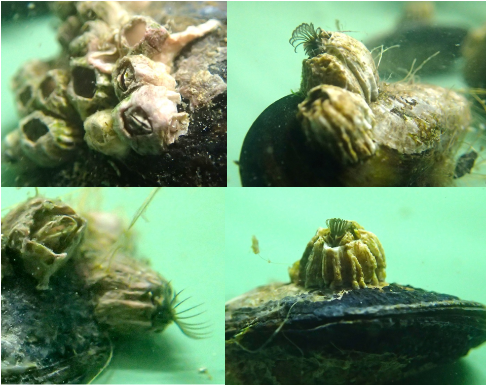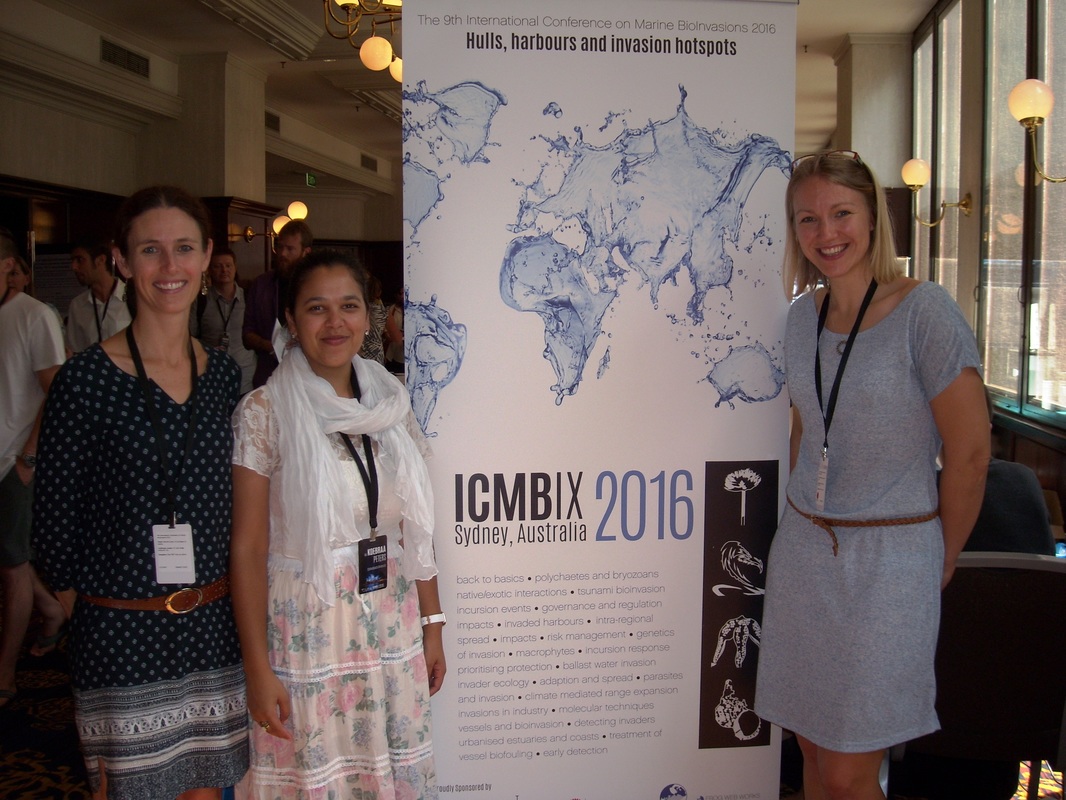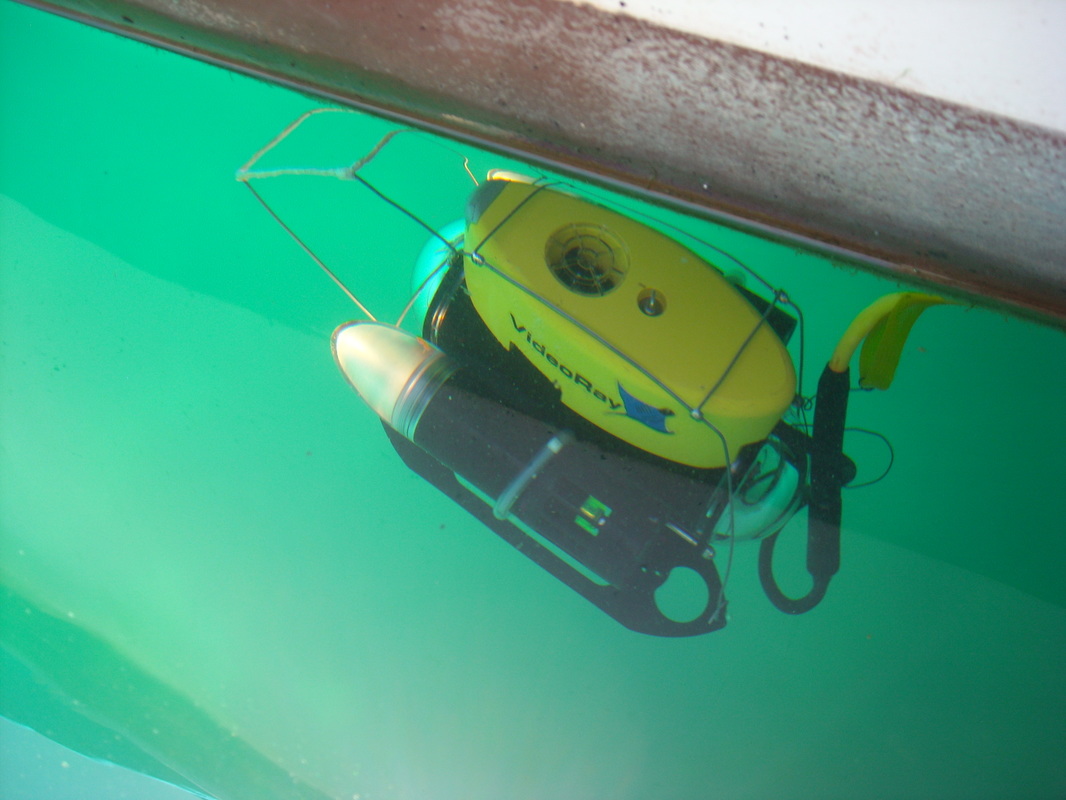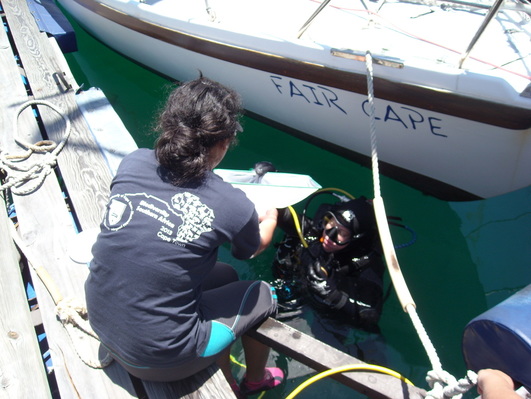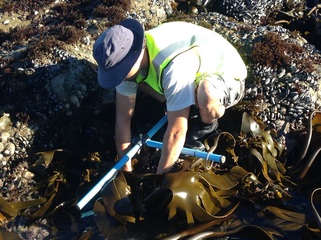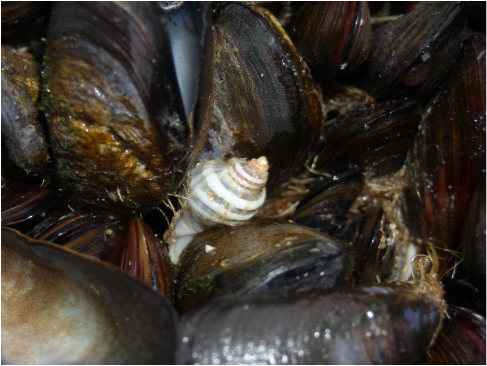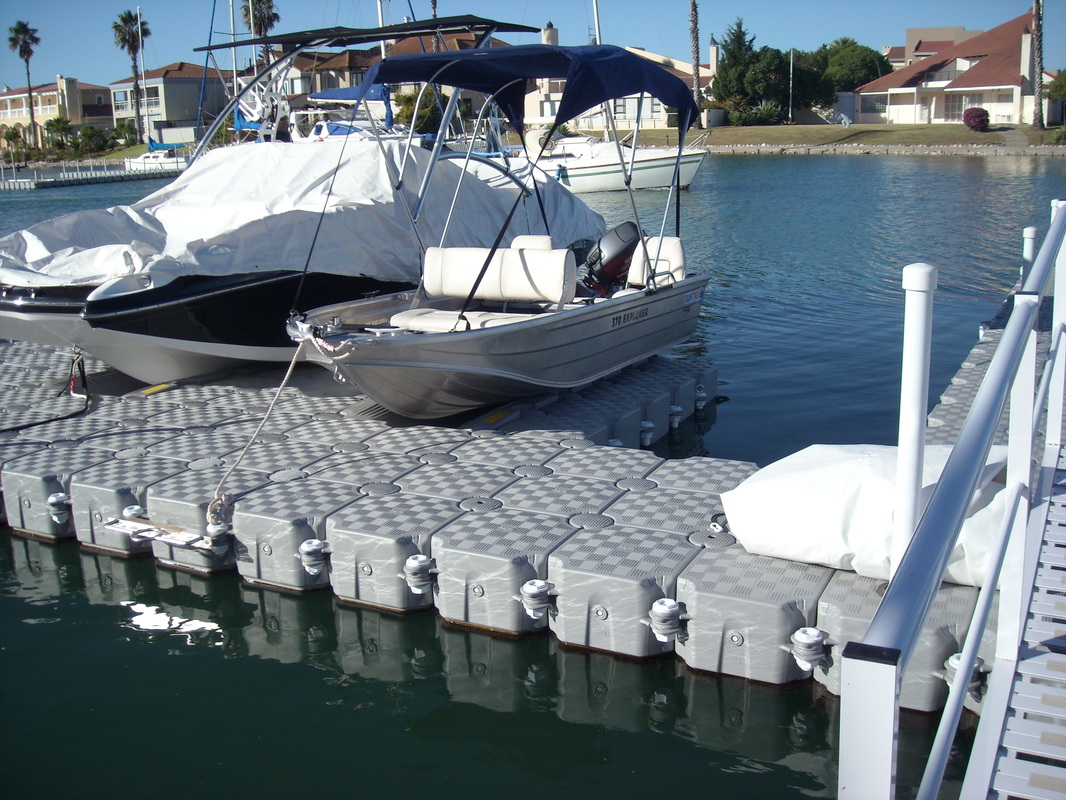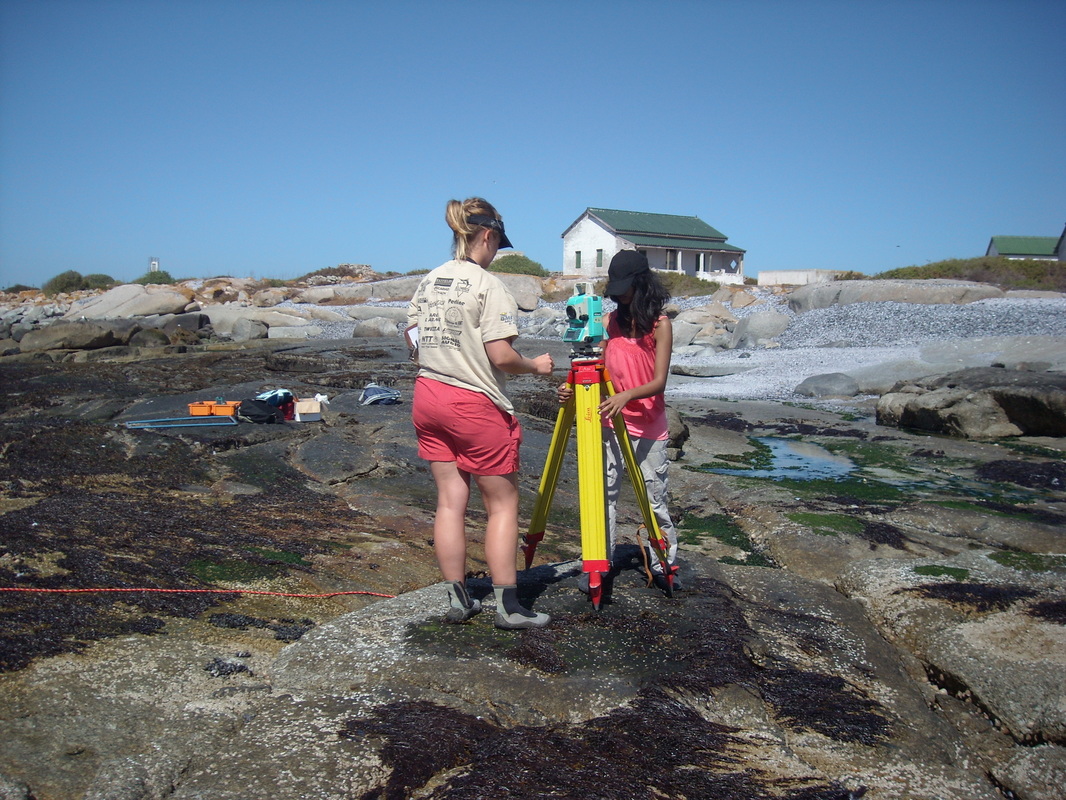Jan 2022: Light, shade and predation: who wins and who loses in sessile fouling communities?
|
Sessile communities are known to be affected by both environmental factors (e.g. light) and interactions that take place between different members of the community (e.g. predation). In a recent study we considered how light and predation interact to control ascidian dominated communities typically found on floating docks. What we found was that colonial ascidians appear most resistant to predation and tolerant to high light conditions. In contrast, solitary ascidians prefer shady areas and may be more susceptible to predators. This work serves as a reminder that to more deeply understand how communities function, we need to consider both environmental and biotic drivers.
Loureiro TG, Peters K, Robinson TB (2021) Light, shade and predation: who wins and who loses in sessile fouling communities? Marine Biodiversity 51: 94 DOI: 10.1007/s12526-021-01241-5 |
Sept 2021: Sampling in one of the most beautiful places on earth
Sampling at Bloubergstrand is a pleasure when you have a splendid view of Table Mountain. Less beautiful are the black alien mussels on the rocks.
Aug 2021: The value of monitoring for alien fouling species
|
Monitoring is a key aspect of any effective management programme of alien species. If we dont monitor we dont know when new taxa arrive, how recognised taxa are spreading and how there abundance may be changing through time. Considering that spread via biofouling is the dominant mechanism by which marine alien species are moved around the globe, the need for a national monitoring programme in South Africa is clear. However, monitoring on its own is of little value. To realise its full value, a monitoring programme needs to be embedded within a comprehensive system of early detection and rapid response (EDRR). Work done on this topic by Dr Taina Loureiro, Dr Koebraa Peters (now of CPUT) and Tammy has recently culminated in a paper proposing just such a system for South Africa.
Loureiro TG, Peters K, Robinson TB (2021) Dropping plates to pick up aliens: towards a standardised approach for monitoring alien fouling species. African Journal of Marine Science 43: 1-15 DOI: 10.2989/1814323X.2021.1989488 |
Looking back at a very productive 2020
|
Despite the challanges faced in 2020, the Robinson lab had a wonderfully produtive year. In total we published ten peer reiwed papers and three book chapters (see the Publications tab for full details). One of the most notable products of the year was a collaborative paper that drew together a number of lab members and our interests in the nexus of invasions and climate change. 'Double trouble: The implications of climate change for biological invasions' was published in a special issue of NeoBiota and addressess how the implications of climate change are likely to vary along the invasion process. Most importantly this paper highlights key requirements for strengthening the management of bioinvasions in the face of a changing environment.
Take a read: Robinson TB, Martin N, Loureiro TG, Matikinca P, Robertson MP (2020) Double trouble: The implications of climate change for biological invasions. NeoBiota 62: 463-487 DOI: 10.3897/neobiota.62.55729 |
April 2020: Staying at home to make a difference
|
Along with most of the world South Africa has been in lockdown for many weeks. There are so many aspects to the Covid-19 pandemic. Invasion biologists will be invasion biologists and many of us see a global invasion playing out. This time we are the vectors, countries have tried to reduce propagule pressure by shutting borders and the alien species is having human health, socio-economic and ecological impacts. While impacts on humans are devastating, there may be positive ecological impacts – at least while people are cooped up nature is left to its own devises.
When the South African government announced that we would be going into lockdown the implications for the lab were clear. Despite having lab studies underway we were able to close down within a few days. With the last field data being collected mere hours from the start of lockdown, we are now all safely working from home. In acknowledgement of the great personal challenges that lockdown brings, our lab is working under the mantra of ‘Be steadfast in your goals but be flexible in your methods’. Families need to be prioritized, children need to home-schooled, statistical analyses are as challenging as ever, new online teaching material needs to be developed and quiet time for writing papers is at a premium. We find ourselves working at strange hours of the day and in unusual places. I am proud of and gratified by the hard work and flexibility that I see within the Robinson Lab. |
February 2020: More is better when it comes to predator driven biotic resistance
When thinking about the ability of predators to resist invasive prey, we often focus on the interaction between a key predator and a newly arrived prey. However, the presence of multiple predators can lead to variation in their behavior and ultimately alter the risk for shared prey. In recent work that formed part of Lisa Skein's PhD we compared the prey selection of whelks and rock lobsters when co-occurring and when feeding in isolation. When alone, both predators preferred the native mussel Choromytilus meridionalis, regardless of the abundance of alternative prey. However, when predators shared access to mussel prey, predation risk of the invasive mussel Semimytilus algosus, increased. This was largely driven by the rock lobsters eating a more varied diet in the presence of the whelks. This finding highlights the need to account for multiple co-occurring predators when assessing the potential for biotic resistance against prey invasions. It is typically South African to think that if a little is good, more must be better - maybe when it comes to biotic resistance we have been right all along.
Skein L, Alexander ME, Robinson TB (2020) Co-occurring predators increase biotic resistance against an invasive prey. Marine Environmental Research 157: 104929 DOI: 10.1016/j.marenvres.2020.104929
Skein L, Alexander ME, Robinson TB (2020) Co-occurring predators increase biotic resistance against an invasive prey. Marine Environmental Research 157: 104929 DOI: 10.1016/j.marenvres.2020.104929
October 2019: Long-term changes in False Bay
Coastal regions face ecological and socio-econonic changes. Understanding the full context of these changes is often hindered by the need for cross-disciplinary knowledge transfer. In an effort to better understand the changes that have taken place in False Bay over the last 30 years, and the implications for the biota and people of the Bay, 32 researchers recently put their heads together. The result is a wonderful holistic synthesis of three decades of change in the oceanography, biology and human dimension of False Bay. This collaborative approach has helped to identify responses to different management approaches and to better understand the implications of changes in human settlements and marine biota. Notably the number of alien species known from the Bay has increased. This likely reflects the spread of a number of alien species from the west coast, the surveying of previously unsurveyed habitats and the discovery of alien species new to the country. For detailed more information read the full paper.
Pfaff MC, RC Logston, SJPN Reamaekers et al. (2019) Three decades of change in the oceanography, biology and human dimension of False Bay, South Africa: a synthesis. Elementa Science of the Anthropocene 7: 32 DOI: 10.1525/elementa.367
Pfaff MC, RC Logston, SJPN Reamaekers et al. (2019) Three decades of change in the oceanography, biology and human dimension of False Bay, South Africa: a synthesis. Elementa Science of the Anthropocene 7: 32 DOI: 10.1525/elementa.367
June 2019: Watch out here they come
Because of the challenges associated with managing alien species in a marine context, it is most effective and efficient to focus efforts on preventing invasions. A useful tool for preventative management comes in the form of watch lists. These lists identify biota that are not yet present in the region of interest but could pose a threat should they establish. Watch lists are most effective when used in conjunction with routine monitoring programs, as new species can quickly be detected. Such a swift response increases the changes of successfully removing newly established alien species. As part of her MSc, Cher used horizon scanning and developed a watch list for predatory crabs. Because of the weak regulatory force exercised by predators along the South African coast, there are concerns that the region is particularly vulnerable to invasions by alien predators.
If you would like to know more this paper has recently been published in African Journal of Marine Science.
If you would like to know more this paper has recently been published in African Journal of Marine Science.
April 2019: Setting up predation experiments around the coast
|
The role that predators play in regulating prey communities is well recognised, In an invasion context this can translate into the exclusion or suppression of alien prey when native predators recognise them as prey. However, if native predators avoid these novel prey they can in fact facilitate their invasion. Over the last weeks we have been setting up experiments that will consider the role that predation plays in regulating fouling communities around the South African coast. Taking place between Saldanha Bay on the temperate west coast and Durban on the sub-tropical east coast this project promises to yield interesting results.
|
January 2019: A new project focused on the interaction between climate change and invasions
The start of the new year sees an exciting new project kicking off in the Robinson Lab. Funded by the National Research Foundation we will be building an understanding of how predicted changes in pH and temperature might affect marine invasions along the South African coast. This project will underpinned by the development of a database of current coastal ocean pH and temperature the accounts for spatial and temporal variability. Using this baseline we will then move on to assessing how future pH and temperature regimes might affect invasions through the combination of field and laboratory experiments. Understanding how the environment might change in the coming decades and what these changes are likely to mean for native and alien biota are the first steps to developing approaches to conserve our marine systems.
November 2018: Successful meetings
Its been a busy few months with lab members attending a variety of meetings.
Tammy and Lisa attended the Xth ICMB in Puerto Madryn, Argentina. This was a wonderfully stimulating conference with attendees from across the globe. It was a great opportunity to see the most recent research before it hits the journal pages. We are very proud that Lisa won the award for second best student oral presentation. Tammy's plenary talk stimulated much discussion about the need to link management and research, and the fact that developing countries face major challenges in this regard.
Back home in Stellenbosch the lab attended the Centre of Excellence for Invasion Biology's Annual Research meeting. This year students were challenged to produce popular science articles for the The Conversation and 3 minute Fame Lab talks. This was a huge challenge but in recognition of the need to make science accessible to the public everyone gave it their best shot. Once again the lab name was held high as Katie was the prize for best popular article by an MSc student. Well done Katie!
Tammy and Lisa attended the Xth ICMB in Puerto Madryn, Argentina. This was a wonderfully stimulating conference with attendees from across the globe. It was a great opportunity to see the most recent research before it hits the journal pages. We are very proud that Lisa won the award for second best student oral presentation. Tammy's plenary talk stimulated much discussion about the need to link management and research, and the fact that developing countries face major challenges in this regard.
Back home in Stellenbosch the lab attended the Centre of Excellence for Invasion Biology's Annual Research meeting. This year students were challenged to produce popular science articles for the The Conversation and 3 minute Fame Lab talks. This was a huge challenge but in recognition of the need to make science accessible to the public everyone gave it their best shot. Once again the lab name was held high as Katie was the prize for best popular article by an MSc student. Well done Katie!
September 2018: Separating out impacts of marine alien species from natural variability
|
The ability to unequivocally demonstrate the impacts of damaging alien species is a challenge shared by all invasion biologists. For those of us working in marine systems this is particularly problematic as we seldom process data-sets that document the pre-invasion state. There are, of course, some welcomed exceptions to this generality. One such example can be found in Marcus Island, a small island that forms part of the Saldanha Bay system along South Africa's west coast. Here detailed intertidal surveys undertaken in the late 1980's provide great insight into what this habitat looked like before the sequential invasions of the Mediterranean mussel Mytilus galloprovincialis, the Chilean mussel Semimytilus algosus and the Pacific barnacle Balanus glandula. During her PhD Dr Saachi Sadchatheeswaran undertook seasonal monitoring of this site that enabled consideration of annual and seasonal variability. When analysed along with historical data a clear picture emerged of how these dominant invaders have altered this system. This work highlights that the impacts of alien species can be distinguished from natural variability by combining long-term monitoring with surveys at finer temporal scales.
Sadchatheeswaran S, GM Branch, CL Moloney, TB Robinson (2018) Impacts of alien ecosystem engineers overwhelm inter-annual and seasonal shifts in rocky-shore community composition on Marcus Island, South Africa. African Journal of Marine Science 40: 137-147. |
August 2018: There is a desperate need for basic ecological knowledge, even for well studied taxa like crabs
In a recent global review of invasions by marine predatory crabs, we highlighted that a lack of basic biological knowledge for the majority of species poses an impediment to identifying traits associated with invasion success. This was somewhat surprising as crabs are large, conspicuous and commonly considered to be a well-studied group. There is a dire need to address this gap, not only for crabs but for other taxa as well. Only through deepening and broadening our foundational knowledge of the ecology of marine groups can we begin to understand the traits that predispose biota to being successful invaders.
Read more about this topic:
Swart C, Visser V, Robinson TB (2018) Patterns and traits associated with invasions by predatory marine crabs. NeoBiota 39: 79-102. DOI: 10.3897/neobiota.39.22002 https://neobiota.pensoft.net/article/22002/
Read more about this topic:
Swart C, Visser V, Robinson TB (2018) Patterns and traits associated with invasions by predatory marine crabs. NeoBiota 39: 79-102. DOI: 10.3897/neobiota.39.22002 https://neobiota.pensoft.net/article/22002/
April 2018: Mussel invasions have unexpected impacts on lobster and starfish predators
|
While a lot of research focuses on the impacts of alien predators, invasive prey species can also have dramatic impacts in their novel ranges. Recent work by Lisa Skein has demonstrated that native rock lobsters (Jasus lalandii) and starfish (Marthasterias africana) exhibit a preference towards the native mussel Choromytilus meridionalis, even when it is the least abundant prey and the most difficult to consume. These results highlight the potential for facilitation of prey invasions, when predators avoid alien prey and select for native comparators that may offer resistance to the invasion through inter-specific competition.
For more on this exciting new work see: Skien et al. (2018) Impacts of mussel invasions on the prey preference of two native predators. Behavioural Ecology 29: 353-359 DOI:10.1093/beheco/arx172 |
February 2018: Getting ready for ICMB-X in Puerto Madryn, Argentina
Every few years marine invasion biologists from all around the world get together to share their insights, findings and enthusiasm for marine systems. The next exciting event will be held in October this year and is being hosted by the Society for the Study of Marine Bioinvasions and Grupo de Ecologia en Ambientes Costeros. Preparations are underway... See you there!
December 2017: Status update - Carcinus in South Africa
|
With invasive populations occurring along the coasts of North America, South America, Australia and Africa, Carcinus meanas has a well earned reputation as a global invader. Impacts in other invaded regions have resulted in this crab recently being recognised in South African legislation as a species requiring control. In an effort to support informed management decisions work undertaken as part of Clovas PhD aimed to update our knowledge on the distribution, population status and demographics of C. maenas in South African waters. Surprisingly, the crab was found to be largely absent from interidal sites, and no crabs were found during subtidal surveys along the open coast. Large populations were, however, recorded in Table Bay and Hout Bay harbours. These results suggest that management actions should target the harbour populations.
For more information see: Mabin CA, Wilson JRU, Le Roux JJ, Robinson TB (2017) Reassessing the invasion of South African waters by the European shore-crab Carcinus maenas. African Journal of Marine Science 39: 259-267. DOI: 10.2989/1814232X.2017.1363818 |
July 2017: Southern African Marine Science Symposium
|
Every three years the marine science community of southern Africa get together at SAMSS. This offers a wonderful opportunity for researchers and students to touch base, share what they have been working on and brew up ideas for new projects. This years conference was hosted in Port Elizabeth and was a great success. With with nine students representing the Marine Lab, we had a great opportunity to showcase our work and learn from what others are doing. The conference theme of 'Unlocking the ocean's economic potential whilst maintaining social and ecological resilience' poses a challenge to us all. If our research is to be relevant we need to embed strong science within a framework that is responsive to the human dimension of the world in which we live.
|
May 2017: The need to quantify impacts of marine alien species
|
In the face of increasing invasions and limited resources, management of invasive species requires prioritisation to ensure efficient use of resources and effective outcomes. When focused at the species level, this process relies on knowledge of species specific impacts. However, studies explicitly measuring impact of marine alien species are rare. This in turn results in prioritisation of management actions often being based on impacts measured from outside the geographic area of interest. Recent work from this lab has highlighted how context dependency in species impacts can render such information uninsightful and ultimately result in management decisions being founded on inappropriate information. While adopting a pathway focused approach to management rather than working at the species level may offer one solution, the reality is that well designed studies of impact are desperately needed to improve our understanding of marine alien species impacts.
For more on this topic see: Robinson TB, Havenga B, van der Merwe M, Jackson S (2017) Mind the gap – context dependency in invasive species impacts: a case study of the ascidian Ciona robusta. NeoBiota 32: 127-141 DOI: 10.3897/neobiota.32.9373 |
March 2017: A new alien arrival
|
While surveying yachts for alien hull fouling as part of her PhD, Koebraa recently recorded an alien species new to South African waters. Commonly known as the Japanese skeleton shrimp, the amphipod Caprella mutica is a successful invader in North American and European waters and is also known from New Zealand. While the vector responsible for this introduction remains unclear, concerns have been raised about the potential role of yachts in the regional spread of this alien.
Read more about this exciting find: Peters & Robinson (2017) First record of the marine alien amphipod Caprella mutica (Schurin, 1935) in South Africa. BioInvasions Records 6: 61-66. |
January 2017: Into the subtidal
|
In an attempt to make the best of the good summer diving conditions, Lisa and a team from the Research Dive Unit have been spending a lot of time surveying subtidal mussel beds along the South African west coast. Although much is known about the status of alien and indigenous mussel within the intertidal zone in this region, surprisingly little is about the subtidal. Thus far the data is revealing intriguing patterns that offer context to interesting lab experiments that Lisa has been running.
|
Koebraa wins award for Best PhD presentation
|
At the end of each year the Centre of Excellence for Invasion Biology gathers for our annual research meeting. This two day event offers an opportunity for students, academics, managers and other role players from across the country to spend time together, taking stock of new developments in the field and progress made during the year. This year, besides key note addresses by world authorities such as Prof Marc Cadotte and Prof Laura Meyerson, the meeting featured a wonderful display of student research. This was a great opportunity for students to highlight their hard work and to learn from others. The standard of presentations was very high and a highlight of the meeting was the presentation of awards for the best PhD and MSc talks. We are very proud of Koebraa Peters who received the award for the best PhD presentation. The topic of her talk was her discovery of a new alien species in South African waters.
|
November 2016: Raising the flag on marine alien fouling species
|
Harbours are well recognised as invasion hot spots, acting as recipients of new introductions and as sources for regional spread. As such, monitoring of harbours can provide information on new introductions and enable rapid management responses to such incursions. Nonetheless managers are often faced with limited resources with which to undertake such monitoring, especially in developing nations. As such these is a need to prioritise harbours for monitoring. In recent work published in Management of Biological Invasions we use subtidal surveys of fouling communities from 14 harbours along the coastline of South Africa to identify predictors of high alien species numbers in harbours. Of the seven predictors investigated , the presence of yachts and low primary productivity were highlighted as indicators of harbours with high numbers of alien species. This suggests that, at least along the South African coast, resources should be focused on monitoring harbours that have these characteristics. Read more about this exciting work that forms part of Keobraa's PhD:
Peters et al (in press) Raising the flag on marine alien fouling species. Management of Biological Invasions |
September 2016: The beauty of Langebaan Lagoon
Roughly 100km north of Cape Town lies a very special spot. Enclosed within the West Coast National Park, Langebaan Lagoon represents a unique system along the South African west coast. Offering protected sandbanks and seagrass beds more typical of the south coast, and a stop-off to many migrating birds, this location holds special significance to many nature lovers. Not least of these are the many students who have been privileged enough to cut their ecology teeth in this special system. This photo was taken from the Geelbek bird-hide by Tammy while spending some time with a group of visiting marine biology staff and students from Plymouth University.
July 2016: So much to do!!
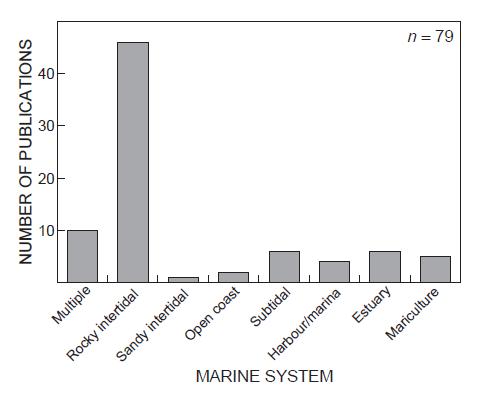
While invasion biology is a growing field, South African marine invasion biology demonstrates this trend perfectly. The first paper was on marine invasions was published in 1990 by a group from George Branch's lab and focused on the detection of the European shore crab Carcinus meanas in Table Bay harbour. Since then the number of papers published has steadily increased with a total of 79 papers appearing the peer reviewed literature by the end of 2014. A recent review has, however, highlighted that much of this work has focused on describing invasions in intertidal systems. This has lead to a call for more experimental research focused on the spread of alien species and their associated impacts. Read more about this topic in a paper recently published by our lab in collaboration with the SANBI Marine Programme and the SeaKeys Project.
Alexander et al (2016) Back to the future: reflections and directions of South African marine bio-invasion. African Journal of Marine Science DOI:10.2989/1814232X.2016.1159984
Alexander et al (2016) Back to the future: reflections and directions of South African marine bio-invasion. African Journal of Marine Science DOI:10.2989/1814232X.2016.1159984
May 2016: Whats in a name?
|
Have you ever heard the saying 'You should compare apples with apples'? Well that sounds quite simple to do. However, a problem arises when people use different names for apples, or when the name 'apple' is used to describe different types of fruit. Amazingly this is a common problem in invasion biology, with the words 'alien' and 'invasive' being assigned different meanings by different researchers. This is particularly problematic for managers of bioinvasions who reply on the scientific literature to inform their decisions. In a recent paper we propose standard terminology for use in South African marine invasion biology. We then interpreted the Blackburn unified framework for biological invasions within the marine context and used this as a transparent way to apply the standardised terms to an updated list of marine alien species for the country. It is hoped that by standardising terminology, South African researchers will better support authorities charged with managing the threat posed by alien species while making their work clear and accessible to an international audience.
|
March 2016: Balanus galndula set to invade the South Coast
|
The intertidal barnacle, Balanus glandula, is one of three dominant invaders along the open coast of South Africa. It is the most common barnacle on the cool and productive West Coast and has recently spread east past the biogeographic break of Cape Point. In a work just published in JEMBE we found that this species displays heightened food resource use when compared to a native comparator regardless of water temperature or food concentration and that this likely reflects different feeding behaviours employed by the two species. Surprisingly, feeding by B. glandula is enhanced under warm water conditions, suggesting that the invasive barnacle may hold an advantage under South Coast conditions that could facilitate its spread. For more details see the lab publication list.
|
January 2016: International Conference on Marine Bioinvasions in Sydney
|
This month saw us make the long trip downunder to attend the International Conference on Marine Bioinvasions in Sydney. This was a wonderfully stimulating conference. The talks were of the highest caliber and the conference gave Koebraa and Clova a chance to show the marine invasion community what their work is all about. We are looking forward to the next conference that will be hosted in South America in 2018.
|
December 2015: Sampling yacht fouling in False Bay
November 2015: A new publication
|
It is essential to maintain accurate lists of alien and invasive species, updating them with new discoveries but also removing species which are no longer present. Tetrapygus niger, the Chilean black urchin, was first recorded in South Africa in 2007 in Alexander Bay on the South African West coast. Recent work by Clova Mabin and team has found that the urchin is now absent from the intertidal and subtidal zones in this area. This is a relief as this species had the potential to significantly impacts kelpbed systems along this coast. In a recent publication we have recommended that this urchin be removed from invasive marine species listings for South Africa. See the lab publication list for more details on this paper. Posted by Clova |
Dr Mhairi Alexander: Moving on to establish her own lab
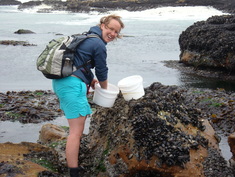
Mhairi Alexander, who was previously a postdoctoral researcher with the Marine Lab has now made the move back to Scotland to take up a lectureship in Animal Behaviour at the University of the West of Scotland, based just south of Glasgow. In this role Mhairi will be teaching on a range of modules on the role of behaviour in animal interactions, a subject area that much of her research has focussed on. She plans to continue her work in South Africa and will maintain strong collaborative links with the Marine Lab.
September 2015: Summer is on its way
|
After a cold but not so rainy winter, spring has arrived at the tip of Africa. Over the last few months we have been very busy in lab and the fruits of our labours will soon show as our hard work has culminated in the acceptance of some new papers. Watch this spot! In addition Mhairi and Saachi represented the lab at the Aquatic Biodiversity and Ecosystems: Evolution, interactions and global change conference in Liverpool. This was an exciting and stimulating meeting that was a great success and enjoyed by all.
Posted by Tammy |
May 2015: A new publication
|
Biological invasions with respect to predator-prey interactions are most often considered in the context of the effect of invasive predators on native prey. But what about when the prey species is invasive? Recently published work coming out of the Marine Lab led by postdoc Mhairi Alexander addresses aspects of this question. Here we investigated how mussel invasions along South Africa’s west coast affects foraging decisions made by a native predator whelk. The study showed when compared to historic feeding preferences towards native mussel species, whelks have shifted their choices and now consume greater numbers of invasive mussels over the native species. What is more, familiarity with one invasive species appears to have facilitated the consumption of a second morphologically similar invasive mussel into the whelks’ diet.
Posted by Mhairi |
April 2015: Port Owen marina
|
The Berg River is one of very few large rivers along the West Coast of southern Africa and enters the sea in St Helena Bay. Having a permanently open mouth and little fresh water input means that salt water penetrates more than 15km upstream from the river mouth. The open mouth also means that this estuary is used as a base by part of local pelagic fisheries fleet and the Port Owen marina. The marina are currently upgrading their walkons and have been very progressive in their approach. On a recent visit I came across these custom modular walkons that boat owners to haul smaller boats out of the water when they are not in use. This means less fouling headaches for boat owners but will also reduce the risk of moving marine alien species around.
Posted by Tammy |

